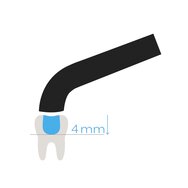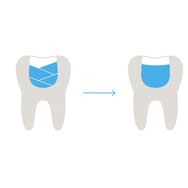Do you remember the time when you were a dental student and you learned how to prepare direct composite restorations using detailed layering techniques? All of it had to be learned in the name of minimising shrinkage stress, preventing voids and ensuring a reliable cure. For over a decade now, bulk-fill composite materials have been available, allowing fillings to be placed in substantially larger quantities. They eliminate the need for time-consuming incremental layering techniques, cure safely in layer thicknesses of 4 to 5mm and, at the same time, exhibit low volumetric shrinkage and shrinkage stress when used in posterior applications. Systematic reviews and meta-analyses have concluded that the success rates of bulk-fill composites are comparable to those of conventional composites.[1,2,3] Yet, bulk-fill materials do not receive the recognition they deserve. For instance, some think that the quality and durability of these restorations are not satisfactory. Are they right or wrong? Myth or fact?
When cross-linking monomers undergo polymerization, they go through a process of radical chain growth. High intensity light generates radicals that target the double bonds in the monomers, leading to the formation of long chains. The rapid growth of numerous polymer chains leads to a firm 3D network, significantly limiting the flexibility of the matrix and causing shrinkage stress. To mitigate uncontrolled chain growth, we developed a chain controller and incorporated it into Tetric PowerFill as a patented ingredient. The task of the chain controller is to break up growing polymer chains. The resulting radical fragments initiate new chains, thereby promoting a more uniform chain growth. This results in a more homogeneous polymer network that reduces shrinkage stress and improves marginal adaptation.[4]
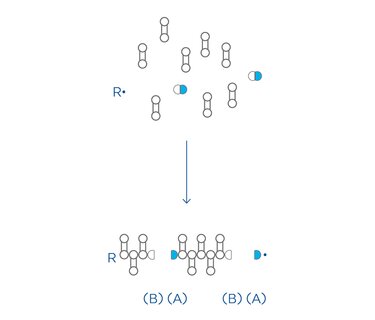
The patented chain controller results in a uniform chain growth, which, in turn, helps reduce shrinkage stress.
It is well known that composite resins shrink during polymerisation. Our bulk-fill composites contain a special filler known as “shrinkage stress reliever”, in addition to the standard fillers. This filler has a low elastic modulus (E-modulus) and a specific surface treatment, enabling it to behave elastically, like a microscopic spring, during polymerisation.[5] Shrinkage stress is alleviated and volumetric shrinkage is reduced due to the low surface area.

Schematic representation of the components of our bulk-fill composites Tetric PowerFill and Tetric PowerFlow.
Traditionally, there has been a belief that voids between the individual layers can be minimised by applying the composite resin in small increments. However, several clinical studies found that large cavities restored with bulk-fill composites showed fewer air entrapments.[6,7] In a study conducted in Brazil, the researchers compared the treatment time and the occurrence of voids when using incremental and bulk-fill techniques to restore Class II cavities with composite resins.[8] They looked at four methods: incremental, bulk-fill, bulk-fill with warm composite and “snowplow” technique. The time required for each restoration using each of the four techniques was recorded. Then, they calculated the volume occupied by the air entrapments. The study found that the incremental layering technique took significantly more time to apply but there were no differences between the bulk-fill techniques. There were no significant differences in the volume of air entrapments between all the techniques employed. Based on their findings, the researchers concluded that the use of bulk-fill techniques shortens treatment times and results in a similar volume of air entrapments as the incremental layering technique.
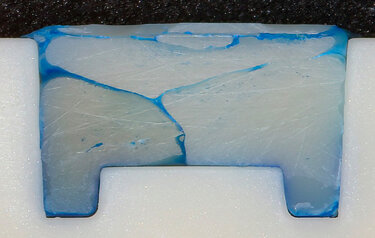
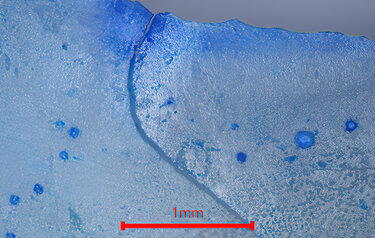
© Dr Richard Price, Dalhousie University, Halifax
Dr Richard Price, Canadian dental clinician and researcher at Dalhousie University in Halifax, Canada, also observed voids, or “knit lines”, in conjunction with the incremental technique.
Bulk-fill composites can effectively cure in layers up to 4mm in thickness. For Tetric PowerFill and Tetric PowerFlow specifically, reliable curing results are ensured through the combination of two technologies: an elevated level of translucency in the uncured state and the patented light initiator Ivocerin. As the level of translucency is higher before the polymerisation process begins, large amounts of light can reach the deep parts of a cavity at the beginning. The initiator Ivocerin effectively absorbs this light, kickstarting the polymerisation process. Because Ivocerin is significantly more efficient at absorbing and utilizing photons compared to conventional initiators, we even call it a “polymerization booster”.
In summary, bulk-fill composites ensure a reliable curing process in deep cavities. When these materials are applied, they result in minimal air entrapments and low shrinkage in the posterior region, all while allowing for significant time savings compared to conventional layering techniques. A systematic review was carried out to explore whether one of these two approaches provided clear advantages over the other concerning certain clinical outcomes.[9] The investigation found that the bulk-fill composites achieved similar clinical results as the incrementally layered composite restorations within the study period of six months to ten years. The five-year survival rates were also considered favourable.[10]
Were we able to convince you of the quality of the 4mm composites? Experience the potential of Tetric PowerFill and Tetric PowerFlow and our products for the direct restorative workflow:
You are still not convinced? Then read the second part of our series on bulk-fill composites, where we will take a closer look at the esthetic properties of these restorations.
Get this product in our online shop
[1] Veloso SRM, Lemos CAA, de Moraes SLD, do Egito Vasconcelos BC, Pellizzer EP, de Melo Monteiro GQ. (2019) Clinical performance of bulk-fill and conventional resin composite restorations in posterior teeth: a systematic review and meta-analysis. Clin Oral Investig. 2019 Jan;23(1):221-233. doi: 10.1007/s00784-018-2429-7.
[2] Yazici AR, Kutuk ZB, Ergin E, Karahan S, Antonson SA. (2022) Six-year clinical evaluation of bulk-fill and nanofill resin composite restorations. Clin Oral Investig. 2022 Jan;26(1):417-426. doi: 10.1007/s00784-021-04015-2.
[3] Tirapelli C. (2022) Is the clinical performance of incremental and bulk-fill resin composite different? Evid Based Dent. 2022 Jun;23(2):84. doi: 10.1038/s41432-022-0264-9.
[4] Gorsche C, Griesser M, Gescheidt G, Moszner N, Liska R. β-Allyl Sulfones as addition-fragmentation chain transfer reagents: A tool for adjusting thermal and mechanical properties of dimethacrylate networks. Macromolecules. Oct 2014: pubs.acs.org/macromolecules
[5] R&D Report Tetric EvoCeram Bulk Fill, Tetric EvoFlow Bulk Fill, No. 20 March 2015. Ivoclar Vivadent AG. https://www.ivoclar.com
[6] Frankenberger R, Reinelt C, Glatthöfer C, Krämer N. (2020) Clinical performance and SEM marginal quality of extended posterior resin composite restorations after 12 years. Dent Mater. 2020;36(7):e217-28. doi:10.1016/j.dental.2020.03.022
[7] Preusse PJ, Winter J, Amend S, Roggendorf MJ, Dudek MC, Krämer N, Frankenberger R. (2021) Class II resin composite restorations-tunnel vs. box-only in vitro and in vivo. Clin Oral Investig. 2021;25(2):737-44. doi:10.1007/s00784-020-03649-y
[8] Soto-Montero J, Giannini M, Sebold M, de Castro EF, Abreu JLB, Hirata R, Dias CTS, Price RBT. (2022) Comparison of the operative time and presence of voids of incremental and bulk-filling techniques on Class II composite restorations. Quintessence Int. 2022 Feb 1;53(3):200-208. doi: 10.3290/j.qi.b2218737.
[9] Sengupta A, Naka O, Mehta, SB et al. (2023) The clinical performance of bulk-fill versus the incremental layered application of direct resin composite restorations: a systematic review. Evid Based Dent (2023). https://doi.org/10.1038/s41432-023-00905-4.
[10] Schoilew K, Fazeli S, Felten A, Sekundo C, Wolff D, Frese C. (2023) Clinical evaluation of bulk-fill and universal nanocomposites in class II cavities: Five-year results of a randomized clinical split-mouth trial. J Dent. 2023 Jan;128:104362. doi: 10.1016/j.jdent.2022.
